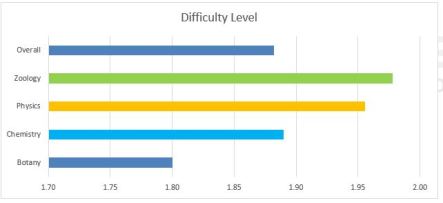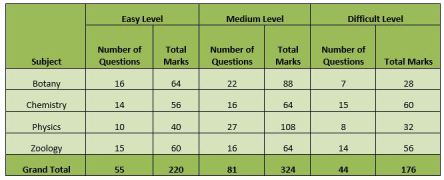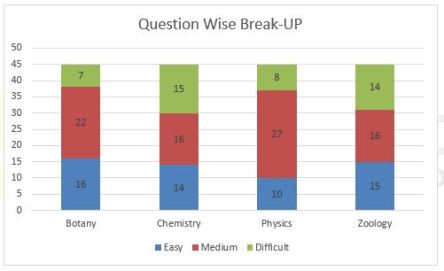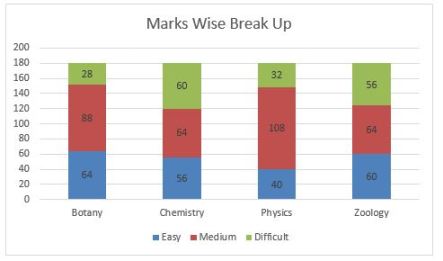As per the directions of honorable Supreme Court, NEET 2016 was conducted as per the schedule (01
st
May 2016) decided for AIPMT 2016. This exam is conducted for entrance
into state and national level medical colleges for MBBS, BDS, BAMS, BHS
courses). NEET exam was first conducted in 2013 and now has been
re-introduced.
Details of NEET (AIPMT) – 2016
NEET 2016 was conducted in one paper consisting of 45 questions each
from Physics and Chemistry, and 90 questions from Biology which consists
of Zoology and Botany subjects (180 questions in total). The exam was
conducted on 01
st May from 10:00 am to 01:00 pm. Given below is the subject wise detailed analysis of NEET-2016 question paper.
Overall Marks Distribution
The paper pattern was same as that of AIPMT 2015. The paper had 180
questions each worth 4 marks. All questions were objective type with
single correct option. If we talk about subject wise, then there were 45
questions from Physics and Chemistry, and 90 questions were from
Biology (Zoology and Botany sections of Biology).

Overall Difficulty Level Analysis
In this analysis we have rated every question on a scale of 1 to 3.
The ratings are done by expert faculty of Resonance. The individual
ratings are then averaged to calculate overall difficulty level.
- 1: Easy
- 2: Moderate
- 3: Difficult
| Subject |
Difficulty Level 2016 |
Difficulty Level 2015 |
| Botany |
1.80 |
1.84 |
| Chemistry |
1.89 |
1.60 |
| Physics |
1.96 |
1.87 |
| Zoology |
1.98 |
1.84 |
| Overall |
1.91 |
1.74 |

Difficulty Level Analysis: No of Questions

Overall, it is felt by Resonance Faculty Team that paper was on tough as
compared to last year and the cut-off is expected to be lower than that
of last year.Resonance Experts feel that all subjects were of similar
difficulty level, while Physics was on marginally tougher side compared
to Biology & Chemistry. Also, Biology was tough compared to last
year and was time consuming. Questions in Physics were easy but required
some lengthy calculation which might have caused some problems. While
around 220 Marks can be considered easy overall, 324 marks are
moderately difficulty and 176 marks are considered difficult by
Resonance Team.
Question Wise Difficulty Breakup

Marks Wise Difficulty Breakup

Subject-Wise Analysis
Physics Analysis
| UNIT & TOPIC NAME |
NO OF QUESTIONS |
TOTAL MARKS |
(%) WEIGHTAGE |
| Physics |
45 |
180 |
100.00% |
| Alternating Current |
2 |
8 |
4.44% |
| Power |
1 |
4 |
2.22% |
| Power Calculation in AC |
1 |
4 |
2.22% |
| Capacitance |
1 |
4 |
2.22% |
| Charging/ Discharging |
1 |
4 |
2.22% |
| Circular Motion |
3 |
12 |
6.67% |
| Banking |
1 |
4 |
2.22% |
| Horizontal Circular Motion |
1 |
4 |
2.22% |
| Vertical Circular Motion |
1 |
4 |
2.22% |
| Current Electricity |
2 |
8 |
4.44% |
| Electrical Instruments |
1 |
4 |
2.22% |
| Power Calculation |
1 |
4 |
2.22% |
| Electromagnetic Waves |
1 |
4 |
2.22% |
| Introduction |
1 |
4 |
2.22% |
| Electrostatics |
2 |
8 |
4.44% |
| Coulomb’s Law |
2 |
8 |
4.44% |
| Fluid Mechanics |
1 |
4 |
2.22% |
| Archimedes Principle |
1 |
4 |
2.22% |
| Geometrical Optics |
3 |
12 |
6.67% |
| Magnification |
1 |
4 |
2.22% |
| Optical Instruments |
1 |
4 |
2.22% |
| Prism |
1 |
4 |
2.22% |
| Gravitation |
2 |
8 |
4.44% |
| Escape Velocity |
1 |
4 |
2.22% |
| Gravitation Potential |
1 |
4 |
2.22% |
| Heat Transfer |
3 |
12 |
6.67% |
| Conductivity |
1 |
4 |
2.22% |
| Radiations |
1 |
4 |
2.22% |
| Refrigeration |
1 |
4 |
2.22% |
| Magnetic Effects of Current |
4 |
16 |
8.89% |
| Magnetic Field |
2 |
8 |
4.44% |
| Magnetic Properties |
1 |
4 |
2.22% |
| Solenoid |
1 |
4 |
2.22% |
| Mathematical Tools |
2 |
8 |
4.44% |
| Vector Algebra |
2 |
8 |
4.44% |
| Mechanics |
2 |
8 |
4.44% |
| Newton Law of Motion |
1 |
4 |
2.22% |
| Rectilinear Motion |
1 |
4 |
2.22% |
| Modern Physics |
3 |
12 |
6.67% |
| Bohr Model |
1 |
4 |
2.22% |
| De Broglie’s Principle |
1 |
4 |
2.22% |
| Photoelectric Effect |
1 |
4 |
2.22% |
| Rigid Body Dynamics |
3 |
12 |
6.67% |
| Centre of Mass |
1 |
4 |
2.22% |
| Moment of Inertia |
1 |
4 |
2.22% |
| Torque |
1 |
4 |
2.22% |
| Semiconductor Devices |
3 |
12 |
6.67% |
| Circuit Problems |
1 |
4 |
2.22% |
| Logic Gates |
1 |
4 |
2.22% |
| Transistors |
1 |
4 |
2.22% |
| SHM and String Waves |
1 |
4 |
2.22% |
| String Waves |
1 |
4 |
2.22% |
| Sound Waves |
2 |
8 |
4.44% |
| Doppler Effect |
1 |
4 |
2.22% |
| Resonance Tube |
1 |
4 |
2.22% |
| Thermodynamics |
3 |
12 |
6.67% |
| Adiabatic Processes |
1 |
4 |
2.22% |
| Calorimetry |
1 |
4 |
2.22% |
| Kinetic Theory of Gases |
1 |
4 |
2.22% |
| Wave Optics |
2 |
8 |
4.44% |
| Diffraction |
1 |
4 |
2.22% |
| Young’s Double Slit Experiment |
1 |
4 |
2.22% |
| Grand Total |
45 |
180 |
100.00% |
Chemistry Analysis
| UNIT & TOPIC NAME |
NO OF QUESTIONS |
TOTAL MARKS |
(%) WEIGHTAGE |
| Chemistry |
45 |
180 |
100.00% |
| Inorganic Chemistry |
15 |
60 |
33.33% |
| Chemical Bonding |
4 |
16 |
8.89% |
| coordination compounds |
1 |
4 |
2.22% |
| D-Block |
1 |
4 |
2.22% |
| Hydrogen |
1 |
4 |
2.22% |
| Metallurgy |
1 |
4 |
2.22% |
| P-Block |
4 |
16 |
8.89% |
| Periodic Table |
3 |
12 |
6.67% |
| Organic Chemistry |
16 |
64 |
35.56% |
| Alcohol |
1 |
4 |
2.22% |
| Aldehydes and Ketones |
2 |
8 |
4.44% |
| Amines |
1 |
4 |
2.22% |
| Biomolecules |
3 |
12 |
6.67% |
| Chemistry in everyday life |
2 |
8 |
4.44% |
| Ether |
1 |
4 |
2.22% |
| GOC |
1 |
4 |
2.22% |
| Hydrocarbon |
2 |
8 |
4.44% |
| Isomerism |
2 |
8 |
4.44% |
| Polymers |
1 |
4 |
2.22% |
| Physical Chemistry |
14 |
56 |
31.11% |
| Atomic Structure |
1 |
4 |
2.22% |
| Chemical Equilibrium |
1 |
4 |
2.22% |
| Chemical Kinetics |
2 |
8 |
4.44% |
| electrochemistry |
1 |
4 |
2.22% |
| Gaseous State |
1 |
4 |
2.22% |
| Ionic Equilibrium |
1 |
4 |
2.22% |
| Solid State |
2 |
8 |
4.44% |
| Solution and colligative properties |
2 |
8 |
4.44% |
| surface chemistry |
1 |
4 |
2.22% |
| Thermodynamics |
2 |
8 |
4.44% |
| Grand Total |
45 |
180 |
100.00% |
Biology Analysis
| UNIT & TOPIC NAME |
NO OF QUESTIONS |
TOTAL MARKS |
(%) WEIGHTAGE |
| Zoology |
45 |
180 |
100.00% |
| Animal Diversity |
1 |
4 |
2.22% |
| General Knowledge |
1 |
4 |
2.22% |
| Animal Physiology |
5 |
20 |
11.11% |
| Circulatory System |
1 |
4 |
2.22% |
| Digestive System |
2 |
8 |
4.44% |
| Respiratory System |
2 |
8 |
4.44% |
| Animal World |
4 |
16 |
8.89% |
| Animal Kingdom |
4 |
16 |
8.89% |
| Biomolecules |
3 |
12 |
6.67% |
| Amino Acids |
1 |
4 |
2.22% |
| Carbohydrate |
1 |
4 |
2.22% |
| Lipid |
1 |
4 |
2.22% |
| Biotechnology |
6 |
24 |
13.33% |
| Application of Biotechnology |
1 |
4 |
2.22% |
| DNA Fingerprinting |
2 |
8 |
4.44% |
| Operon Model |
1 |
4 |
2.22% |
| Plasmid |
1 |
4 |
2.22% |
| Polymerage Chain Reaction |
1 |
4 |
2.22% |
| Endocrine System |
3 |
12 |
6.67% |
| Endocrine Glands |
3 |
12 |
6.67% |
| Evolution |
4 |
16 |
8.89% |
| Analogous Organs |
1 |
4 |
2.22% |
| Homologous Organs |
1 |
4 |
2.22% |
| Origin of Life |
1 |
4 |
2.22% |
| Theory of Evolution |
1 |
4 |
2.22% |
| Health and Disease |
4 |
16 |
8.89% |
| Cancer |
1 |
4 |
2.22% |
| Immunology |
3 |
12 |
6.67% |
| Human Physiology |
4 |
16 |
8.89% |
| Nervous System |
1 |
4 |
2.22% |
| Respiratory System |
3 |
12 |
6.67% |
| Living World |
1 |
4 |
2.22% |
| Biological Classification |
1 |
4 |
2.22% |
| Microbes |
2 |
8 |
4.44% |
| Microbes useful to human welfare |
2 |
8 |
4.44% |
| Pollution |
1 |
4 |
2.22% |
| Water Pollution |
1 |
4 |
2.22% |
| Reproduction |
6 |
24 |
13.33% |
| Female Reproduction |
2 |
8 |
4.44% |
| Human Reproduction |
2 |
8 |
4.44% |
| Reproductive Health |
2 |
8 |
4.44% |
| Tissue |
1 |
4 |
2.22% |
| Structural Organisation of Animal |
1 |
4 |
2.22% |
| Cell |
3 |
12 |
6.67% |
| Cell division |
2 |
8 |
4.44% |
| Cell Organelles |
1 |
4 |
2.22% |
| Cell Biology |
1 |
4 |
2.22% |
| Cell Organelles |
1 |
4 |
2.22% |
| Cell: Structure and Function |
3 |
12 |
6.67% |
| Cell Cycle |
1 |
4 |
2.22% |
| Cell Cycle and division |
1 |
4 |
2.22% |
| Cell: The unit of life |
1 |
4 |
2.22% |
| Cell: The Unit of Life |
1 |
4 |
2.22% |
| Cell |
1 |
4 |
2.22% |
| Diversity in Living World |
6 |
24 |
13.33% |
| Biological Classification |
1 |
4 |
2.22% |
| Plant Kingdom |
5 |
20 |
11.11% |
| Ecology |
7 |
28 |
15.56% |
| Biodiversity and Conservation |
3 |
12 |
6.67% |
| ecosystem |
2 |
8 |
4.44% |
| Environmental Issues |
1 |
4 |
2.22% |
| Organism and Population |
1 |
4 |
2.22% |
| Genetics |
5 |
20 |
11.11% |
| molecular basis of inheritance |
1 |
4 |
2.22% |
| Principle of Inheritance and variation |
4 |
16 |
8.89% |
| Plant Physiology |
7 |
28 |
15.56% |
| Mineral Nutrition |
1 |
4 |
2.22% |
| Photosynthesis |
5 |
20 |
11.11% |
| Plant growth and development |
1 |
4 |
2.22% |
| Principle of Inheritance and Variation |
1 |
4 |
2.22% |
| Genetics |
1 |
4 |
2.22% |
| Reproduction |
5 |
20 |
11.11% |
| Sexual Reproduction in flowering plants |
5 |
20 |
11.11% |
| Structural Organisation of Plant and Animals |
6 |
24 |
13.33% |
| Anatomy of Flowering Plants |
2 |
8 |
4.44% |
| Morphology of Plants |
4 |
16 |
8.89% |
| Grand Total |
90 |
360 |
100.00% |
|
Expected Cutoff
| NEET – 2016: TENTATIVE# CUTOFF TABLE |
| CATEGORY |
% RESERVATION |
CUT-OFF MARKS* |
% CUTOFF |
| Unreserved |
50.5% |
439 |
60.8 |
| OBC (NCL) |
27.0% |
433 |
60.1 |
| SC |
15.0% |
296 |
41.1 |
| ST |
7.5% |
288 |
40 |
| TOTAL |
100.0% |
|
|
| NEET – 2016: Maximum Marks |
720 |
| # The Cut-off of NEET – 2016 is
estimated on the basis of Previous Year Data and Toughness Analysis of
NEET – 2015 Paper by Resonance Experts. These are not official data
released by Authorities concerned. |










No comments:
Post a Comment